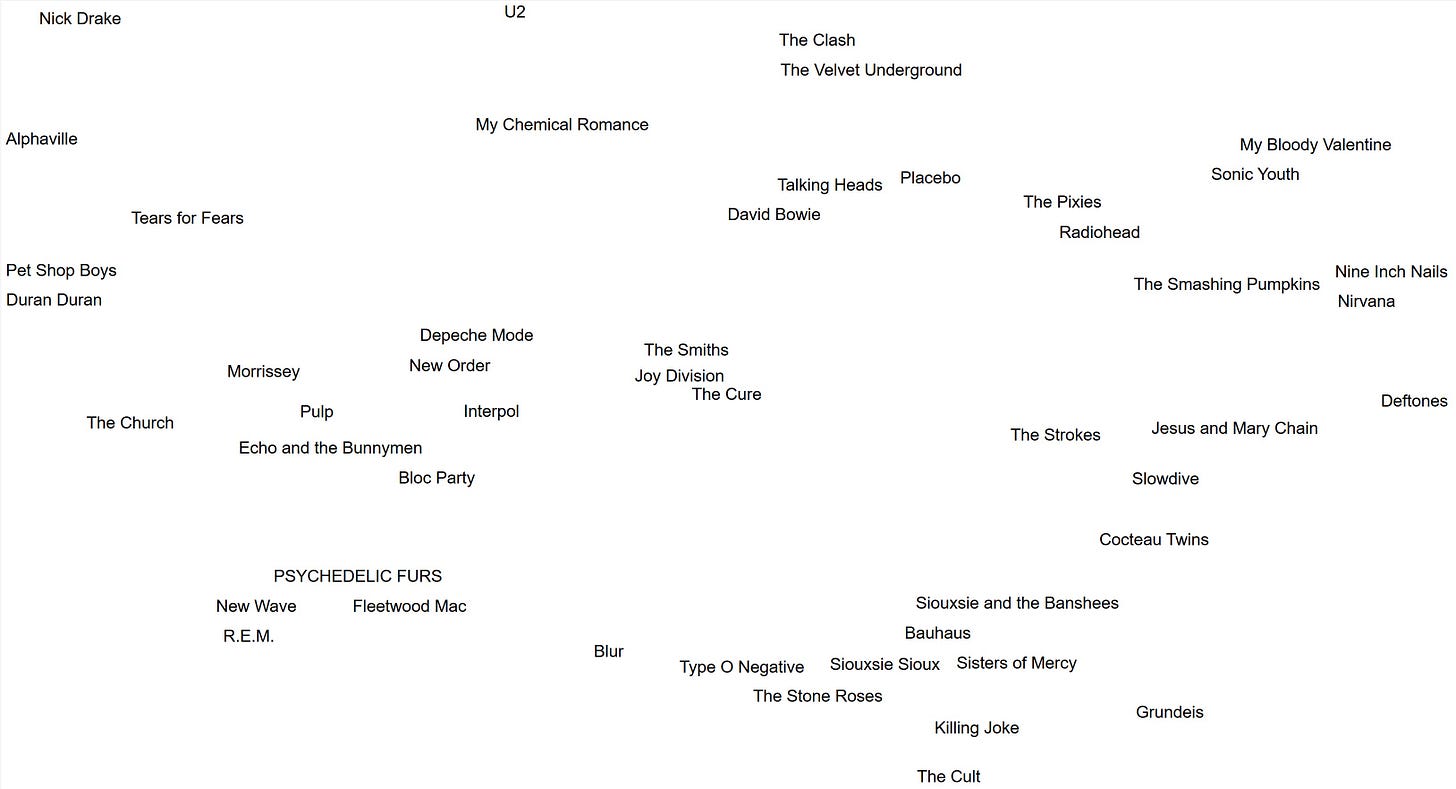Navigate A Little Known Artist Map To Find Your Future Fans
One Search Can Reveal Thousands Of New Music Lovers Waiting To Hear Your Sound
There’s a hidden gem of an online research tool that could seriously boost marketing efforts to grow your Fanbase – Music-Map. It’s a completely free, interactive webpage where you can explore how different music artists are “connected” through shared fans and listening habits.
Let’s break down and show how this clever little resource can sharpen an understanding of your broad target audience. It will help elevate “effective” reach and relevance of your music marketing content.
What is Music-Map?
It’s an online discovery tool visualising relationships between well known music artists, based on fan overlap and listening preferences. Just type in any artist’s name and Music-Map generates a two dimensional, “constellation” view of related ones. The closer artist names are grouped, the higher degree of fan similarity.
It’s quick, easy and, most importantly, 100% free. Think of it as a shortcut to the minds (and playlists) of your potential future fans!
Here is an example: I searched for a band close to my heart – The Cure. Here’s what Music-Map shows me:
You can see bands like Joy Division, The Smiths, as well as Depeche Mode, New Order, Interpol and David Bowie clustered closely to The Cure in the centre of the visual. Unsurprisingly perhaps, this suggests a significant overlap in listeners between these artists.
Why Emerging Artists Should Use Music-Map
Challenge Your Biases With Objective Data
Every musician has personal influences. The reasons you started playing an instrument, singing or making music is a big part of the passion to what you create. However, marketing music based solely on what you like can lead to missed opportunities. You may unintentionally exclude entire fanbases because of unconscious biases.
Take my earlier example with The Cure. I was never a big fan of Morrissey’s personal style, meaning I may have skipped specifically marketing to the fanbase of The Smiths. My unconscious bias would be a silly mistake – because the data shows there’s a major overlap between fans of both bands.
Music-Map let’s you take a step back from your personal tastes and look at the fan landscape with cold, fresh, objective eyes. It may also reveal artists you wouldn’t have ever considered. Alphaville would not have been on my radar as a potential crossover band with The Cure, albeit they’re at the outer limit of the visualised relationship!
Build Detailed Fan Personas
Once you are clear which other artists align with your core influences, you can begin building realistic audience personas. These are fictional, yet research-based profiles, helping you define your ideal fans using their cultural, psychological and personal characteristics.
A solid method to create such personas is to close your eyes and imagine the ideal fan is sitting opposite you, simply having a chat about your favourite music. Ask yourself:
Who are they?
What do they listen to?
What’s their name?
What do they look like?
How do they dress?
How do they talk?
Do they remind you of anyone you know?
The more personalised you can be about picturing your ideal fan, the better you can tailor your branding, social media tone, and any marketing content. It’s as if you were actually speaking one-to-one.
Hone Your Advertising Targeting
Running paid ads on platforms like Instagram, Facebook, TikTok, YouTube or Spotify? You’ll want to target the most relevant audiences of course. Music-Map can help you go beyond the more generic options like age, sex, location, or even broad music genre interests, like “indie music”, “hip-hop music”, or “Spotify.”
Armed with the constellation charts from Music-Map, you can target fans of individual, similar artists via interest groups, channels or keyword. This level of granularity can significantly improve ad performance.
Taking my earlier example to create a campaign on Meta platforms (Facebook / Instagram), I could set-up three distinct ad sets targeting fans of The Cure, Joy Division and The Smiths. This could reach at least 4.5 million people across the UK and USA alone.
Monitoring which group engages most with my content would allow me to refine and optimise targeting options, leading to further performance gains over time.
This tactic can really transform your ad campaigns to become more data-led at set-up, ensuring your budget goes further.
Guide Your Content and Platform Strategy
Better understanding who your audience is, and who else they love, can shape what kind of content you create and where you choose to post it.
Let’s say your musical style is close to a well-known artist doing well with lo-fi studio clips on TikTok or stripped-down, acoustic sessions on YouTube. These are your clues. Lean into the trends you see and hear and put your own spin on it. Mirror what works for your audience – but make it yours.
Music-Map can highlight content opportunities by showing you which artists are in your lane, enabling you to observe what platforms they’re winning on.
At first glance, Music-Map may seem like just another simple, online visualisation gimmick. But with the right application, it can be a powerful research assistant.
For independent musicians without access to a big team or data budget, this resource offers a sneak peak into how music fans cluster around their main influences. It puts power in your hands to make smarter, conscious marketing decisions – without losing your creative soul!
If you’re at the start of your music marketing journey, don’t overlook the value of understanding:
Who is your potential audience
Where you can reach them
How you should speak to them
Music-Map is completely free and simple to try. Get using it to uncover hidden audience gems, potential new targeting angles and refine your marketing approach.
If nothing else, it’s quite addictively fun to play around with, to see how different artists overlap!



